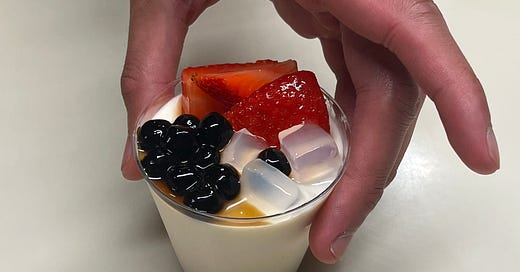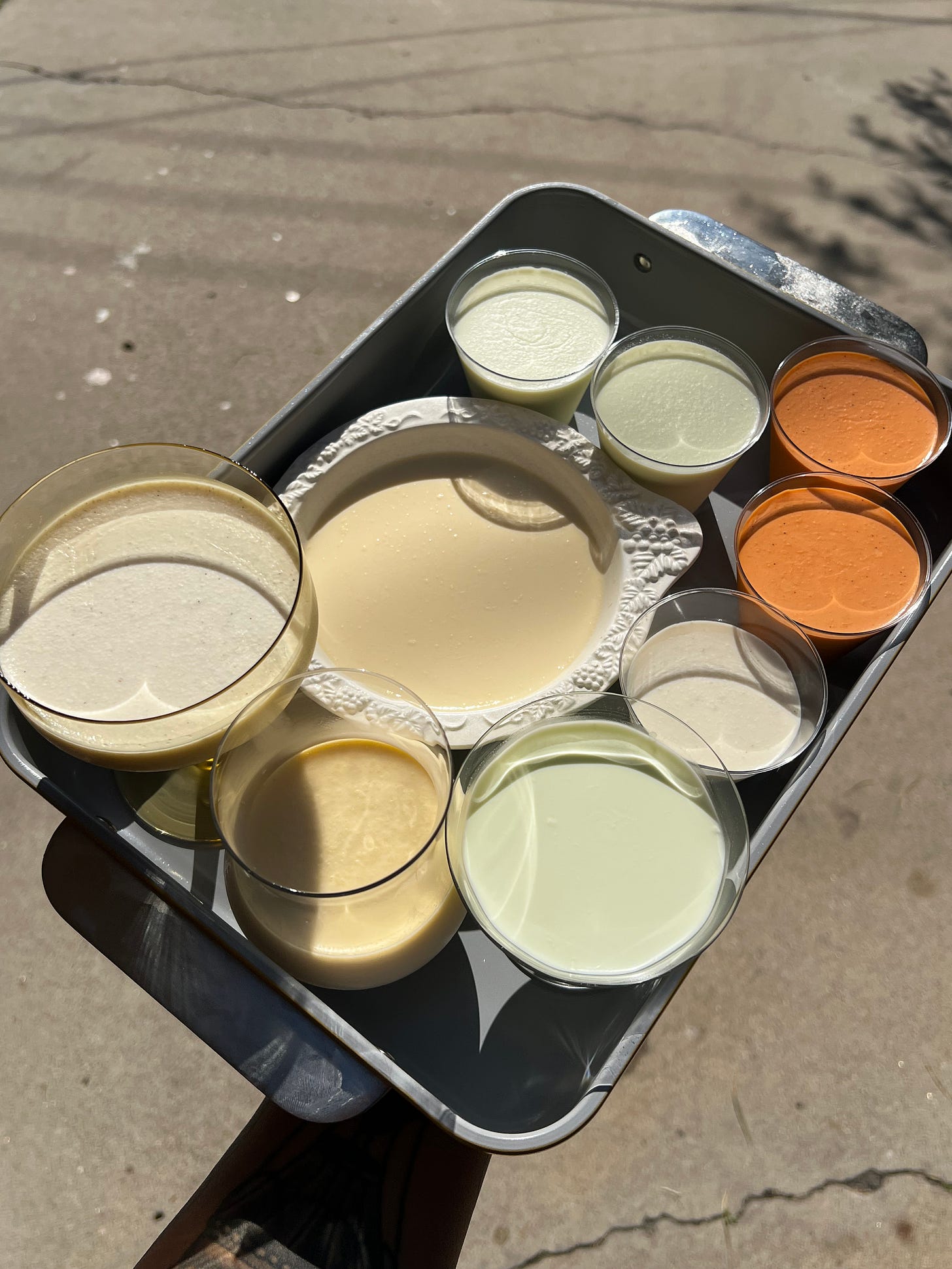recipe riffin': panna cotta 100 different ways
actually 4 different ways but you can really do whatever ya want with it
hey hi hello!!
Time for more ✮ ⋆ ˚。𖦹 ⋆。°✩ free will baking ✮ ⋆ ˚。𖦹 ⋆。°✩ (though, now I’m thinking recipe riffs is a more appropriate series name whoops)!!
Today we are going in on panna cotta (4 flavor options for ya, with another on the way- but the possibilities are endless). Because as y’all may or may not know, I do not have a working oven at home right now, so I’m currently partial to no bake desserts. Which that’s fine, things are heating up here in San Diego and the thought of turning an oven on right now? grody brody.
Working oven or not, I love a panna cotta. She should be top of mind for all your spring and summer party needs. Because, well panna cotta is, like stupid easy to pull together. Bloom gelatin. Heat milk to dissolve gelatin and sugar. Add heavy cream. Let set. Ba da bing ba da frickin’ boom.
Because panna cotta is so easy I think its a great place to kind put some foundational skills/techniques/thought processes in place for your recipe riffin’, free will baking journeys.
First up, infusions/steeping:
Tbh, if you’ve got a recipe with milk or water this is a great way to add a little flavor. Things like herbs, whole spices, nuts, teas, assorted leaves (hey, peach leaf), edible flowers, citrus peels, cereals… um I’ve infused cookies into milk… All I’m saying is you’ve got options when it come to infusing. Like I said, this isn’t just something you do for panna cotta, any milk/heavy cream situation or water can be infused for use in a recipe. We’re talking ice cream bases, pastry creams, rice puddings, the soak of a tres leches cake, flans— I could keep going but I’m hoping, you’re picking up on what I’m putting down.
When it comes to infusing, be mindful of the fact that what ever you choose to infuse will take on some of the liquid you’re infusing it into. Some, more than others. So, if you need 100 grams of milk for a recipe, you could infuse 150 grams with _____ to account for liquid lost. You should always reweigh in the end and top off with a little more milk/water/whatever to meet the amount needed for the recipe.
When I can (aka I think far enough ahead) I prefer cold steeping for delicate ingredients like fresh herbs, teas and the occasional leaf- which, yeah is what tea is but, you know what I mean…maybe. Because intense heat can damage the delicate flavors, bringing out bitter, tannic and unsavory notes. Infuse for 48 hours, like I said when ya can.
With things like fresh herbs, and teas when I haven’t thought far enough ahead (most of the time), I’ll heat the liquid for steeping just enough to take the chill off. Around 100F but, nothing higher than 120F. For things like herbs, I’ll chop them up finer for more surface area for a stronger flavor extraction. Infuse for 30-45 minutes.
For things like nuts, coffee grounds, whole spices, I’ll heat the milk to just below a simmer before cutting the heat and adding the ___ in for infusion. In most cases with a warm infusion, I’ll steep anywhere from 30 minutes to an hour before straining and using the liquid as the recipe calls for. Be sure though, to use the liquid at the temp the recipe calls for! So, if ya need room temp milk for a recipe make sure to cool it down before using.
*When infusing heavy cream for a whipped cream though, be very careful not to over heat it. Too much heat causes the fat to break its bond and even if you cool it back down, it will still whip up grainy*
Swapping dairys:
So, for these panna cotta I use melon milk and banana milk for flavor. Which, is pretty much as simple as subbing out milk for flavored milk. These flavored dairy bevs can substitute some of the milk in an ice cream recipe, pastry cream recipe, even a chiffon cake etc etc. BUT, something to keep in mind, these drinks come with added sugar, so ya gotta lower the amount of sugar you add to the recipe to keep things balanced. In the case of panna cotta, the extra sugar would make things a little too sweet. But, in the case of a cake, the added sugar could affect the crumb/structure of the cake (could be for the better, could be for the worse, better to err on the side of caution though).
To find out how much sugar you should be omitting from the recipe, you’re gonna have to do a little math. Look at the nutrition facts, drop them peepers down to where the amount of added sugar is. Look at that vs the serving size vs the amount of the ingredient you plan to add. Using the cartons of banana milk as an example, each carton is one serving. Each serving contains 15 grams of added sugar. I used 2 cartons in the place of some of the milk in the recipe. Therefore, we are adding 30 grams of sugar when we add-in the banana milk. So, to counter that, we drop the amount of sugar in the recipe by 30 grams.
This little bit of math applies really anytime you’re playing around with an ingredient that has added sugar. Let’s keep with the flavored milk, but instead of using pre-mixed cartons, let’s say we want to add some of the classic highlighter pink strawberry Nesquik syrup. Add what it takes to get the milks flavored how you like it, keeping note of how much you add. The syrup has 13 grams of sugar per 20 gram serving. So, you may find that you don’t need to add any additional sugar to your panna cotta based on the amount of syrup you add.
And, there’s always just like alt dairy milks in general. Right, cow’s aren’t the only ones producing milk. You can get you hands on goat’s milk, sheep’s milk and even camel’s milk (very expensive, not my favorite milk, but you can and that’s the point) Each, producing it’s own unique flavor profile.
Extracts/alcohols:
For the vanilla panna cotta, I use a “little” vanilla bean paste. But, I mean the possibilities for extracts are virtually endless. The lil freaks in the extract factories are working over time to bring us extracts and flavorings of things like cotton candy, root beer, ylang ylang, bacon extract??- the list goes on. So, maybe instead of always defaulting to vanilla, get a little crazy with it.
All extracts are not created equally though, some come across a lot stronger in flavor than others at a lower amount added. Looking at you almond extract!! So before going balls to the wall and swapping extracts one for one, try an little less, and taste as you go to nail the right amount to add.
You can also, use alcohols in place of extracts, considering most extracts are alcohol based to begin with. I love pairing a little bit of cointreau with things that are very vanilla forward, because of it’s citrus notes. Frangelico finds a home in my chocolate chip cookie recipe from time to time with notes of hazelnut. We almost never used vanilla in cookies when I was growing up, rather a hefty splash of Captain Morgan.
Alcohols can affect gelatins ability to set up properly. A tablespoon or two (depending on batch size) won’t hurt. But, if you decide, you know what let me make a very boozy eggnog panna cotta, you’ll have to adjust the amount of gelatin used to get the same level of setting power. Gelatin bonds with water to gel and set up. Alcohol is well, alcohol with no water content, which is why is can get in the way of your gelatin based desserts ability to set.
*This post contains affiliate links. That means that if you make a purchase after clicking on a link I may earn a small commission at no extra cost to you. *
Panna Cotta Recipe (Base/Vanilla):
So, I buy my gelatin in a 1 pound tub, because overall it works out to be a little cheaper than buying packets. I have better control of how much gelatin I’m using. I use gelatin pretty often because you know I’m a big fan of jello. So, anyways, all of that to say- This recipe calls for 8 grams of gelatin, which is one gram more than what the individual packets hold. The gram does make a difference, BUT, if all you’ve got is a single Knox gelatin packet, well then just use that. It’s not worth it to open a second packet for a gram. I tested with them, and the set isn’t as strong. It’s got less hold, so not ideal for an unmolded panna cotta moment, more like a live in the vessel she’s served in.
Tools:
Medium Saucepan
Rubber spatula
Serving vessels of your choosing, but, we love a good coupe
Ingredients:
350 grams whole milk, cold
8 grams (2 teaspoons) powdered gelatin
100 grams granulated sugar
1/2 teaspoon diamond crystal kosher salt
1 tablespoon vanilla bean paste *optional*
400 grams heavy cream
Directions:
Add your 350 grams of cold whole milk to a saucepan.
Sprinkle the 8 grams of powdered gelatin over top of the milk. Allowing the gelatin to bloom for about 10-15 minutes.
After the gelatin has fully bloomed in the milk, the 100 grams granulated sugar, 1/2 teaspoon kosher salt and 1 tablespoon vanilla bean paste to the milk + gelatin.
Bring this to just before a simmer. Just warm enough and long enough to melt the gelatin and dissolve the sugar. You do not want your dairy to boil at any point of this process.
Once the gelatin and sugar have both dissolved into the warm milk take the saucepan off the heat and add in the cold heavy cream. Stirring to combine.
In the case of panna cotta with vanilla beans, you’ll want to place the pot into an ice bath and stir the mixture every 10 minutes or so over the course of an hour, until the mixture cools and begins to thicken. This way the beautiful beans are studded throughout rather than sinking to the bottom. They’ll suspend more in a slightly thickened milk.
Pour the mixture in the the serving vessels of your choice. I love a good coupe for panna cotta. But, truly anything works. For ease of transfer to the fridge, place all the panna cotta on a sheet tray to move them all at once.
Allow to set in the fridge for a minimum of 4 hours before serving.
If unmolding to serve: Dip the the vessel of the panna cotta into hot water for 3-5 seconds, depending on the thickness of your vessel it may take a little longer as well. The outer edge will melt ever so slightly. Place your serving plate over top panna cotta and invert. The panna cotta should release with a few gentle shakes.
Serve up and enjoy <333




